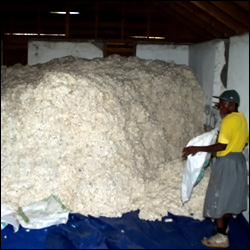
Sea Cotton From The Island Of Nevis
Charlestown, Nevis
May 15, 2008
The final push towards the first export of Sea Island Cotton from Nevis to Japan commenced on May 13, 2008, when the New River Ginnery cranked into motion after a four-year suspension, to gin 22,000 pounds of raw cotton.
The Department of Agriculture had taken a decision in 2007, to reintroduce the cotton crop following growing interests and high prices offered by Japanese importers.
Small Farm Equipment Pool Manager Mr. John Parris who had been involved in cotton ginning operations since 1979 said in an interview during the Department’s Eye on Agriculture NTV Channel 8 programme, that it took some doing to get the equipment ready for processing the first crop, since they had not been in operation for some time.
“First we had to order a set of parts from the United Kingdom because the machines are up to 70 years old and we had to go directly to a parts company. So we acquired the necessary parts and also the bailing material because once you process the cotton, you have to do bailing for the finished product and over the last two three weeks, I worked on reinstalling the machines.
“The Small Farm Equipment workers we came over and refurbished all the machines because they were out of service for over four years. We have three out of four running. The reason why the fourth is not working is because we have to make up a conveyer to feed into the knives so maybe over the next year or so we will get that going as well,” he explained.
Mr. Parris said the ginnery had received raw cotton only from the government owned farms so far and had planned to receive cotton from private farmers for processing the first run early next week.
He also explained the ginning process which began with the sided cotton taken manually from the storage area on the ground floor of the building to the top floor where the gins were situated.
“Once the cotton is here, we have laborers in the back feeding the seeded cotton into the machine and we have another set at the front receiving the end product that is pure lint. There is another area that the seeds fall into some bins beneath and that goes on for storage for replanting as well as sometimes the excess we feed to animals. Then as we get the end product [lint] we pass it into the bailing area and as we get to the bailing press the laborer there would feed it into the press and the press gather it into a manner that we strap it into a 500 pound bail what you see as a finished product down stairs,” he said.
Mr. Parris said the raw cotton could not be exported with the seeds because the end users/buyers only wanted the lint with no foreign matter, stains or discolouration. Therefore the process had to be carefully done.
He said in the past persons had to clean the cotton before ginning but so far he said some of the cotton had been picked and brought straight into storage which has allowed some trash from the field during harvesting to get through.
With regard to exportation, he said the final product had to “look good” and at the same time packaged in a manner that it would survive the long journey to the buyer in Japan via Florida.
Notwithstanding, he said the gins could produce about 80 pounds of lint per hour once the machines continued to work in top condition.
“On average with the gins working in “A1″ condition, it does 80 pounds of lint in an hour and that 80 pounds of lint is a third of what went into the gin because if you put in 300 pounds seeded cotton into the feeder, you would have 100 pounds of lint coming out. It is a rough average of one third lint, to two thirds seeds”¦
“With what [the cotton] we have it would take six good working days to complete it because we have to bear in mind that sometimes a machine has to stop for some sort of maintenance because sometimes things go in and bind them up, sometimes a belt or anything go off, sometimes we have to reset them as we go along as well,” he said.
Mr. Parris said in terms of quantity, the gins could handle any amount of cotton harvested and in the past they had ginned in excess of 100,000 pounds of raw cotton at one time but that matter remained in the hands of the planters
“Looking towards the future it’s all about the planters. If the planters can produce it whatever quantity they can bring to the gin we can handle it here.
“Once the cotton is here in the ginnery we can do something like 6,000 pounds of seeded cotton in a day,” he said.